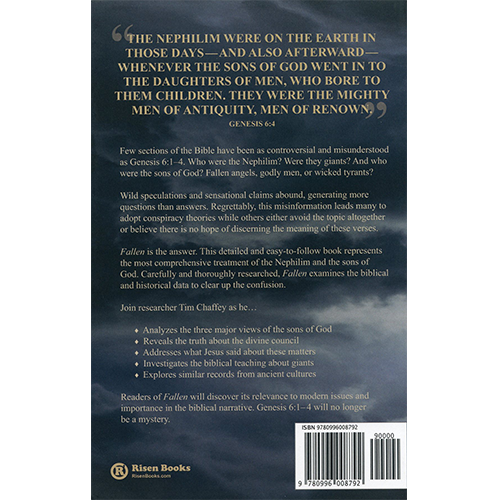The Nephilim and the Sons of God — An Introduction
Genesis 6 includes a passage that has become one of the most confusing in the entire Bible, although this wasn’t always the case.
And it came about, when mankind began to multiply on the face of the earth, and daughters were born to them, that the sons of God saw the daughters of men, that they were beautiful. And they took for themselves wives from any they chose. And Yahweh said, “My spirit will not remain with man indefinitely, in that he is flesh; his days will be one hundred twenty years.” The Nephilim were on the earth in those days—and also afterward—whenever the sons of God went in to the daughters of men, who bore to them children. They were the mighty men of antiquity, men of renown. (Genesis 6:1–4)
These four verses have spawned scores of questions. Who were the sons of God? Were they fallen angels? Kings? Judges? Men descended from Seth? Who were the daughters of men? What’s the deal with the 120 years that God mentioned? And what about the Nephilim—what does the word mean? Were they giants? If so, how tall were they? Were they the offspring of the sons of God and women? How could they have been on the earth before and after the Flood? This sampling of questions reveals how puzzling this passage has been for many people.
Bible commentaries offer a variety of answers to many of these questions and often gloss over others. Contributing to the confusion are hundreds of websites and articles filled with misinformation on every one of the questions above. Many self-proclaimed experts rely on these wrong ideas and unwittingly mislead their followers. Add the fringe ideas of conspiracy theorists to the mix and we are left with a muddled mess.
What are we to make of this situation? Many choose to neglect these verses because they are just too controversial or too difficult to understand, but for Bible-believing Christians this approach is inadequate. The Holy Spirit made sure these verses were recorded for us, so we should do our best to understand them in a way that makes sense of the terminology and context, and our conclusions must not contradict other passages of Scripture. This article is the first in a series dedicated to that goal. In this introduction, we will cover a few basics and plot our course for the upcoming articles.
Who were the sons of God?
Three major views have been promoted by Christians to identify the sons of God (in Hebrew bene ha’elohim). Unfortunately, some believers get quite upset during this discussion, so we encourage you to remember that this topic is not a salvation issue. Godly men and women have disagreed over the correct interpretation of the passage for centuries. There is no need for Christians to condemn each other if they happen to reach different conclusions on these verses.
The Sethite View, which dominated most of church history, sees the sons of God as men from the line of Seth (mentioned in Genesis 5) who married women from the line of Cain (mentioned in Genesis 4). Yet, as far as we know, the Sethite View is actually the last of the three to be developed.
The Royalty View argues that the sons of God were nobles or highly respected judges who thought of themselves as divine or were considered to be divine by their subjects. These nobles took common women and forced them to join their harems. The Royalty View was developed among rabbis in the late first or early second century AD.
The Fallen Angel View, the earliest known position among both Jewish and Christian writers, maintains that the sons of God are heavenly beings that left heaven and sired children with women. This is based on the fact that in the other Old Testament passages where bene ha’elohim is found, it refers to heavenly beings. This view dominated Jewish writings on the topic until the early second century AD and Christian writings until the fifth century AD.
Before moving on, it is important to briefly address the most popular objection to the Fallen Angel View. Many people claim that Jesus ruled out such a possibility in Matthew 22:30 when He stated that in the resurrection, believers will not marry nor be given in marriage and they will be “like angels in heaven.” Thus, these people conclude that angels cannot marry. If this is what Jesus said, then we would agree that the fallen angel view cannot be correct. But this is not what the verse says. Jesus specifically stated that the angels in heaven do not marry. He was speaking of godly angels in heaven and what they do not do. He did not address what rebellious angels can do on earth. Many additional objections to this view and the others will be addressed in upcoming articles.
Who were the Nephilim?
The first thing to notice is that although many readers conflate the two groups, the Nephilim were not the same entities as the sons of God. However, one’s view on the identity of the sons of God usually guides their understanding of the Nephilim. Depending on how the beginning of verse 4 is translated, the Nephilim were either the offspring of the unions described in the passage, or they were already on the earth when those marriages took place.
The King James Bible translates the Hebrew word (nephilim) as “giants.” Verse 4 states, “There were giants in the earth in those days…” This same term also appears twice in Numbers 13:33, which records the Israelite spies’ report when they returned from investigating the Promised Land, the land of Canaan. The 12 spies described very tall people in the land and depicted themselves as grasshoppers compared to these giants.
Many Bible translations simply transliterate the term so that verse 4 begins with something like, “The Nephilim were on the earth…” This reflects the debate over the meaning of this word. Many people claim that the word is related to the Hebrew verb naphal (“to fall”). Thus, they see the Nephilim as “fallen ones,” so from this perspective, they were either warriors who “fell upon” their enemies or extremely wicked people who had fallen far from God, morally speaking.
Moving Forward in Our Research and Discussion of the Nephilim
The upcoming articles in this series will examine the issues raised in this introduction. First, we will take a closer look at the three views on the sons of God to see if a firm conclusion can be reached. Then we will seek to clear up the confusion about the Nephilim—the meaning of the word, their origin and height, and more. Finally, this series will conclude by looking at the passage as a whole to help readers make sense of how it fits into the context of Genesis, and how it provides us with a greater understanding of what the Holy Spirit revealed through Moses.
So open up your Bibles and join us for a fascinating study of one of the most intriguing and debated passages in God’s Word.
For more study on the Nephilim, check out these resources!












